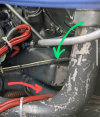- Joined
- Jul 17, 2019
- Messages
- 1,933
- Location
- Chicago suburbs
- Display Name
Display name:
The Little Arrow That Could
Updates: (and thank you to all who continue to parse through this and offer suggestions  )
)
Did another test flight today and couldn't get the alternator to fail. Amps/Voltages looked the same as yesterday's reported values.
Following the test flight I spent the next several hours verifying every electrical line I could think of in the aircraft. Cowl off, seats out, got up under the panel with bright lights + telescoping mirrors and lots of photos.
ENGINE COMPARTMENT WIRES:
This is the area where I found stuff I didn't like.
When the alternator got rewired at annual I think the cables from the alternator got moved down so now they're resting directly on the exhaust pipes from the engine. From my own diagnosis the wires look like they're not doing great down there.
There's some black gunk building up under the black shielded cable (the bigger wire / lower gauge line), and the smaller white cable appears to be a bit dirty and also with some brown marks (burns?).
mirror reflection, brown marks on the white line look like burns? (if it is, not sure if from heat or electrical load)


There's some black crud building right where the black shielded (big) wire is resting on the exhaust. Is it from the heat? Or rubbing against it and causing chaffing/friction? Combo of both?

Here's the big/small wires coming off the alternator itself

Most sections of the wire near the engine compartment look a little dirty/aged, but I do not see any exposed wire.

Couple spots where its worn through the shielding by the ties but wire insulation still looks fully intact.

INTERIOR WIRES:
From what I could tell the interior wires all seemed to have good, sturdy, shielded connections to their terminals. It's complicated as all hell back there, but every wire seemed to be firmly attached and in good condition (1 exception).
Also I found a couple links from the breaker box that don't seem to line up with the component they're hooked up to. I have to investigate that a bit more. I'm going to look at these a bit more in my photos before I post.
Did another test flight today and couldn't get the alternator to fail. Amps/Voltages looked the same as yesterday's reported values.
Following the test flight I spent the next several hours verifying every electrical line I could think of in the aircraft. Cowl off, seats out, got up under the panel with bright lights + telescoping mirrors and lots of photos.
ENGINE COMPARTMENT WIRES:
This is the area where I found stuff I didn't like.
When the alternator got rewired at annual I think the cables from the alternator got moved down so now they're resting directly on the exhaust pipes from the engine. From my own diagnosis the wires look like they're not doing great down there.
There's some black gunk building up under the black shielded cable (the bigger wire / lower gauge line), and the smaller white cable appears to be a bit dirty and also with some brown marks (burns?).
mirror reflection, brown marks on the white line look like burns? (if it is, not sure if from heat or electrical load)


There's some black crud building right where the black shielded (big) wire is resting on the exhaust. Is it from the heat? Or rubbing against it and causing chaffing/friction? Combo of both?

Here's the big/small wires coming off the alternator itself

Most sections of the wire near the engine compartment look a little dirty/aged, but I do not see any exposed wire.

Couple spots where its worn through the shielding by the ties but wire insulation still looks fully intact.

INTERIOR WIRES:
From what I could tell the interior wires all seemed to have good, sturdy, shielded connections to their terminals. It's complicated as all hell back there, but every wire seemed to be firmly attached and in good condition (1 exception).
Also I found a couple links from the breaker box that don't seem to line up with the component they're hooked up to. I have to investigate that a bit more. I'm going to look at these a bit more in my photos before I post.















